Elizabeth Stewart's Blog
September 11, 2025
BIG Changes in the Art World
 2019: what a year! The art and design world CHANGED that year, and we thought it had changed forever. More of us want to forget the year 2019 because important changes happened to the consumer market for fine art and design. 2019 marked a watershed moment in the art world, especially at the end of 2019 as we learned of the impending lockdown.
2019: what a year! The art and design world CHANGED that year, and we thought it had changed forever. More of us want to forget the year 2019 because important changes happened to the consumer market for fine art and design. 2019 marked a watershed moment in the art world, especially at the end of 2019 as we learned of the impending lockdown.
The dust still hasn’t settled on the trends begun during the pandemic, namely that most of the buying public purchased fine art and great design online. High-end collectors, who often spend more money than you and me, learned to use the big auction house websites. If they didn’t purchase online themselves, collectors of great art and furniture hired experts. The galleries that continued to serve collectors, like our wonderful and resilient Sullivan Goss, showed their strength and kept their clients during this highly turbulent period.
Five plus years later… In mid-2025, things have again changed. The forced, insular nature of the “lockdown” taught us a harsh lesson. The sheer number of online sales from home offices and dining room tables 2020-2023 created a new asset class: art and high-end design purchased not so much for pleasure or status but for investment purposes, similar to a purchase of stock in a hot corporation.
In mid-2025, things have again changed. The forced, insular nature of the “lockdown” taught us a harsh lesson. The sheer number of online sales from home offices and dining room tables 2020-2023 created a new asset class: art and high-end design purchased not so much for pleasure or status but for investment purposes, similar to a purchase of stock in a hot corporation.
A recent report by Artnet News predicts the art market may return, as we progress through 2025, to more traditional art and traditional values. Those values are becoming less financial, more about the purchases of traditionally classic art.
In summary, art as an “industry” isn’t the primary focus of the art world in mid-2025. Money isn’t the primary determinant of the value of a work of art as I write this newsletter, according to the databases that track trends and sales. Leading indicators are those facts, figures, and trends sourced from Christie’s, Sotheby’s, and Bonhams-Skinner, as well as smaller auction houses, galleries and dealers, including tastemakers in the art world.
Fascinating trends mid-year 2025; a year of a reversal of trends set back in 2019: Fine art sales at auction are down approximately ten percent compared to this time last year. Collectors, likewise, pay at ten percent LESS for a work of art.Next Gen buyers as well as seasoned collectors pressed pause on purchases of hot new fashionable art. They now focus on those works with a solid record of accomplishment, such as Modern Masters—those names we all know.The fastest growing trend is the purchase of “Old Master” works of art—big names of the 17th through 19th centuries in painting, drawing, and sculpture. “Classic” works of art sales rose twenty-five percent over last year’s sales. For example, Christie’s NY in November will sell the collection of luxury resort tycoon Elaine Wynn. The collection is expected to fetch over $75 million. The earliest painting in the collection is also one of its highest-estimated lots. Joseph Mallord William Turner’s Ehrenbreitstein, or The Bright Stone of Honour and Tomb of Marceau from Byron’s Childe Harold, estimated at up to $18 million.The ultra-contemporary market, which includes works by young and fashionable “art stars” is down thirty percent as collectors want reliable track records of a work’s value, and make less “trophy” purchases.Art, once seen as a reason to pay millions, is now seen as an arena for ALL collectors. Great leaders of the art world, such as the retired head of the Guggenheim, Mariet Westermann, suggests museums might begin to share their entire collections, “like some of us share Ubers,” quoted in Artnet News, September 2025.The world is becoming more conservative and less speculative.
Fine art sales at auction are down approximately ten percent compared to this time last year. Collectors, likewise, pay at ten percent LESS for a work of art.Next Gen buyers as well as seasoned collectors pressed pause on purchases of hot new fashionable art. They now focus on those works with a solid record of accomplishment, such as Modern Masters—those names we all know.The fastest growing trend is the purchase of “Old Master” works of art—big names of the 17th through 19th centuries in painting, drawing, and sculpture. “Classic” works of art sales rose twenty-five percent over last year’s sales. For example, Christie’s NY in November will sell the collection of luxury resort tycoon Elaine Wynn. The collection is expected to fetch over $75 million. The earliest painting in the collection is also one of its highest-estimated lots. Joseph Mallord William Turner’s Ehrenbreitstein, or The Bright Stone of Honour and Tomb of Marceau from Byron’s Childe Harold, estimated at up to $18 million.The ultra-contemporary market, which includes works by young and fashionable “art stars” is down thirty percent as collectors want reliable track records of a work’s value, and make less “trophy” purchases.Art, once seen as a reason to pay millions, is now seen as an arena for ALL collectors. Great leaders of the art world, such as the retired head of the Guggenheim, Mariet Westermann, suggests museums might begin to share their entire collections, “like some of us share Ubers,” quoted in Artnet News, September 2025.The world is becoming more conservative and less speculative.Here are some auctions happening on Artnet. The titles of the auctions reflect this trend of more conservative directions:
 20th Century Art Live Now
20th Century Art Live NowThis auction showcases the evolution of art throughout the 20th century, highlighting the ways artists reacted to, and found inspiration in their predecessors and the world around them.GEMS: Collecting Post-War Abstraction
A marquee auction showcasing Post-War Abstraction and Colorfield painting. This auction offers vibrant paintings and works on paper—a nod to the founding movement of Modern Art in America.Museum Grade: Photographs and Prints
September photographs auction highlights the achievements of artists who currently exhibit in the world’s most prestigious public institutions. And Premier Prints & Multiples: Biggest prints sale of the season showcases works by some of the most popular artists on the market, from striking Pop pieces to bold street art.
The post BIG Changes in the Art World appeared first on Elizabeth Appraisals.
September 9, 2025
A Different Eagle Full of Symbolism
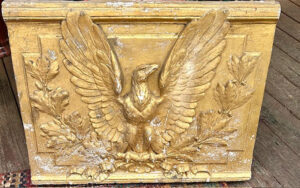 KC sent me a “relief” three-dimensional image of an eagle. This work created out of plaster, a plaque, boxed in the image on three sides measures seventeen by twenty-eight inches. KC found it in the basement of an antique dealer years ago.
KC sent me a “relief” three-dimensional image of an eagle. This work created out of plaster, a plaque, boxed in the image on three sides measures seventeen by twenty-eight inches. KC found it in the basement of an antique dealer years ago.
Instead of the typical spread-wing eagle associated with American iconography, KC’s eagle shows wings pointing straight up, similar to those in Roman Classical design. Instead of the typical American symbols of the olive branch in the dexter, right talon, and arrows in the sinister, left talon, this eagle holds the olive branch in the sinister and an oak branch in the dexter talon. American bald eagles on coins, the Great Seal designed in 1782, architecture, and Federal furniture feature a stars and stripes shield over the eagle’s breast.
KC’s eagle IS DIFFERENTWhat’s the eagle’s origin? The key to KC’s eagle is the symbol of the eagle itself, representing kings, power, and the status quo. This goes back to Greek mythology in the eagle of Zeus, and later in Roman times, the symbol of Jupiter, the King of the Gods, as his eagle, his messenger, or incarnation. Charles Thomson, American Secretary of the Continental Congress in 1782 modified this Classical eagle iconography to feature the bald eagle, a true American native species, for the Great Seal.
We find animal images used as symbols of strength in many mythologies. I mentioned the eagles of Zeus and Jupiter. There‘s also Ibis of Thoth in Egyptian culture. In Hinduism there’s the eagle-man Garuda, and Ganesha, the god with the elephant head.
Animals Symbolize Certain AttributesFor millennia the eagle represented kingship, dominion, strength, power, wealth and majesty. In the 17th and 18th century the eagle meant the power of money, thus the symbol’s incorporation in money, symbolizing financial power. Also used in a family crest (heraldry). Eagle images were used in Europe and America on architecture that represented national wealth, family wealth, and banking.
KC’s eagle, with its oak and olive branches, most resembles eagles associated with banking and financial institutions. The symbol of the oak tree represents solidity. The olive branch symbolizes peace. When associated with money, the images mean wealth and stability.
The American dime of the late 19th century features both the olive and the oak branch. Although these two symbols aren’t paired with an eagle, but with a torch on our ten cent coin. The olive branch is seen on the left of the torch.
I found a similar eagle, with an olive and oak branch, and upright wings in the Roman style, on French and American architecture and objects associated with banking of the 19th century. French banks of the period bore emblems of both the oak and the olive branch, with or without an eagle symbol.
The French Eagle ConnectionThe connection between the eagle of French monetary symbolism, and the American monetary symbolism are close cousins. Congress debated the establishment of the US National Bank as an institution for our young country 1789-1801. History calls this the Federal Period because French and American finances became closely associated, for good and bad, profit and debt. The US borrowed greatly from France, and France demanded that debt repaid. Debate over banking and national debt waged between American French supporters and isolationists. In 1795 the US settled its French debt and begun in earnest our own National Bank.
KC’s eagle was designed in relief on plaster which means this plaque was part of a wall or building, thus, incorporated into architecture. Perhaps once an emblem of a bank. I surmise they didn’t create it for an American bank. Plaster was used for exterior decorative elements throughout the 19th century, and I assume this created in the mid to late 19th century with a European origin.
KC, I can’t give you a value on this plaque, but I postulate $500-ish. We’ve uncovered these details: it’s most likely French and associated with banking, It served as part of a structure as a decorative object, and it symbolized solidity, power, and stability.
The post A Different Eagle Full of Symbolism appeared first on Elizabeth Appraisals.
September 6, 2025
Nomad Tango Presents Malena
Nomad Tango Executive Director Alejandra Folguera joins choreographer and dancer Fernanda Ghi to talk about the production of Malena—the story of a woman’s rebellion and her fight to claim her freedom at the Lobero Theatre on Saturday, September 6.
Watch Video

The post Nomad Tango Presents Malena appeared first on Elizabeth Appraisals.
September 2, 2025
The Seven Gods of Fortune
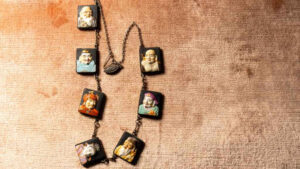 JE owns a wonderful 1900s vintage Japanese necklace composed of faces of benevolent gods. The links are porcelain on sterling.
JE owns a wonderful 1900s vintage Japanese necklace composed of faces of benevolent gods. The links are porcelain on sterling.
The faces, and the gods they belong to, are important to Japanese mythology, the Seven Gods of Fortune. We see them pictured on kimono toggles called netsuke, and in woodcuts since the 1600s. Although this necklace pictures them individually, they’re often grouped together on a ship at sea, a lovely ship of treasures. Tradition calls those treasures: longevity, prosperity, popularity, integrity, dignity, kindness and magnanimity. The gods that personify each virtue bestow these blessings. Although the Seven Lucky Gods are immortal, the Buddhist priest of the powerful Shogun Mikawa “discovered” the gifts they bestow on good people in the 1500s. The Seven Gods, called the ‘Shichifukujin’ have been recognized in art—and it seems, in dreams, for over 500 years. Let’s meet the Gods and what they embody. Then we’ll meet them in dreams.
In order of the necklace, the Seven Gods:Ebisu, a god of Japanese origin, who reigns over fishermen, farmers, and merchants, and stands for integrity. We see Ebisu pictured on Sapporo Beer cans! Ebisu is celebrated at his shrine in Osaka each year in a race in which the fastest runners compete. Those who win are the “lucky men” blessed with a year of good fortune.Daikokuten is the god of wealth, prosperity and agriculture, akin to the Hindu Shiva, who destroys and creates.Benzalten is goddess of kindness, the only female, and rules over wisdom and music.Bishamonten is dignity, a warrior god.Fukurokuju is popularity and good luck for and with children.Jurojin is longevity, pictured with a deer, he cures illnesses.Hotei is magnanimity, and he carries a sack to give to the poor. He grants wishes.The Toshikane Company made this necklace in the first or second quarter of the 20th century in the rich porcelain making area of Arita. Chief designer Minami designed sculptural objects prior to World War II.
After the war, Japanese companies resumed private export trade in 1947. Thus, these necklaces and buttons made with faces of the gods sold as souvenirs through military bases in Japan and Guam to western servicemen. Surprisingly, the Toshikane Company continued to make “Gods of Fortune” buttons, in the style of Japanese Noh Masks, until 1975. The necklace bears a stamp “made in occupied Japan” The Seven Gods necklace is circa 1940s, happy porcelain faces set upon silver, linked with a silver chain.
Prized Jewelry and Lucky DreamsThese masks on jewelry are prized, as the gods are powerful and immortal. People have celebrated them for centuries in Edo (now Tokyo). Pilgrims visit the shrines of each of the lucky gods there in the new year. Wear this necklace to undertake the walking “Yahaka” pilgrimage to each of the seven shrines. If you cannot visit the seven shrines, the traditional practice is to invite these gods into your home. Do this as a custom. Sketch each god in their pleasure ship on paper, and on New Year’s Eve, place that sketch under your pillow. This encourages the lucky “first dream” of the New Year.
The tradition of “hatsuyume” (first dream) indicates the vision you see as you doze at the start of the year will predict the next twelve months. Hatsuyme originated in the 1660s with the first Edo shogun. One of Japan’s most powerful rulers, he lived in the shadow of Mt Fuji, Japan’s tallest mountain, and kept the fastest hawks for his hunt, and the earliest seasonal purple eggplants to eat.
Every New Year, hawkers in the streets sell sketches of the Seven Lucky Gods in their ship. This is because not everyone can draw, and putting such a work of art, called a ‘takarabune’ picture under your pillow increases the chances of a great dream of
Mount FujiHawksEggplantsThe Seven Gods increase the chance you’ll dream of these three, and if you want added protection, ask for a sketch of the Kanji Monster who eats bad dreams.
The value of the lucky gods necklace is $500. But if JE owns a set with hair ornaments and earrings and a bracelet, the value is $1,000.
The post The Seven Gods of Fortune appeared first on Elizabeth Appraisals.
August 31, 2025
Lies at Center Stage Theater
Director R. Michael Gros and playwright Jerry Slaff join founders of DramaDogs A Theater Company, E. Bonnie Lewis and Ken Gilbert, to talk about the West Coast premiere of Lies at Center Stage Theater.
Watch Video

The post Lies at Center Stage Theater appeared first on Elizabeth Appraisals.
August 26, 2025
Atmos Mantle Clock A Go-To Gift
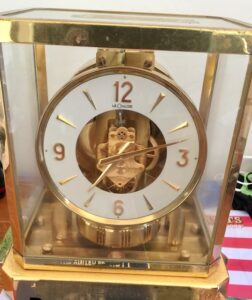 Imagine a clock that winds itself based on changes in atmospheric pressure. This Atmos clock doesn’t need a human. It winds itself with the help of a sealed bellows of ethyl chloride. When the temperature rises, the metal spring condenses. When the temp falls, the metal spring expands, and the mainspring winds. Because the clock is so delicate, a pendulum with practically no friction and hangs off a wire thinner than a human hair. This Atmos clock is the brand of a torsion pendulum clock made by Jaeger-LeCoultre of Switzerland.
Imagine a clock that winds itself based on changes in atmospheric pressure. This Atmos clock doesn’t need a human. It winds itself with the help of a sealed bellows of ethyl chloride. When the temperature rises, the metal spring condenses. When the temp falls, the metal spring expands, and the mainspring winds. Because the clock is so delicate, a pendulum with practically no friction and hangs off a wire thinner than a human hair. This Atmos clock is the brand of a torsion pendulum clock made by Jaeger-LeCoultre of Switzerland.
Clocks that ran on atmospheric pressure were invented in the 17th century and refined throughout the 18th century.
A particularly noteworthy torsion pendulum clock is the Beverly Clock in Dunedin New Zealand. A human hasn’t touched it since 1864. It still tells accurate time.
I love this Gold and Crystal Atmos nine-inch mantel clock with its modern case. HK’s grandfather received it as a gift like many VIPs in the mid-20th century. Many boxed Atmos clocks were presented since the 1940s. Not the least of the ‘givers’ is and was The Atmos Mantle Clock became the go-to gift for the Swiss government to give visiting dignitaries since the 1950s.
The brand is my favorite:The US version is gold-plating over brass with five panel crystal casing. The Swiss made other models for dignitaries from Japan, featuring views of Mt Fuji and a pagoda. The Marina design features motifs of the ocean. The ribbed brass model and a round or square faced model sell at auction under $1,000. Black enamel round-face models go for $1,500. The clock shows different outward casing styles but technically contains the same internal workings since 1946. From retirement to wedding gifts, the Atmos reflected a relationship honored because Atmos reflected reliability, dependability, accuracy, and beauty.
A version of the Atmos mantel clock called the Moonphase retails today, used, for $10,000. It’s the same torsion pendulum Atmos clock set in a case of plated Rose Gold and crystal. The difference is that the Moonphase tells the time, month, and moon phases, and is NOT accurate only once in every 3,821 years.
Swiss engineer Jean-Leon Ruetter invented the Atmos in 1928. It became commercially produced by Jaeger-LeCoultre in 1936. Antoine LeCoultre formed Jaeger-LeCoultre in 1833. They’ve patented thousands of clock movements. For example, the world’s smallest movement, the world’s most complicated movement, and the perpetual movement of the Atmos clock.
Wristwatches Too!My business manager Shawn collects unique wristwatches. He loves the wizardry of the Tourbillion movement Jaeger-LeCoultre Grand Complication. Called the Hybris Mechanica a Grand Sonnerie this wristwatch designed in 2009 will set you back $2.5 Million. For $2.5M you get treats for the ear. Sonnerie means ”chimes,” and yes, the watch contains miniature tiny gongs and hammers that play miniature chimes inside that watch. Because of its 1,300 parts and complex tiny gears, it plays the entire Big Ben Chime Song. It also plays the Westminster Chime Song as well as showing you the time and perpetual calendar for the date, day, month, and leap year. The challenge to the watchmaking industry in the creation of the Grand Complication, is the precise engineering needed to find more complexity in a relatively small wristwatch. To solve the complexity problem in mechanically engineered miniature ways that are NOT digitally based, but mechanical.
If, in 1980, your Casio beeped every hour, this $2.5Million dollar Hybris Mechanica a Grand Sonnerie wristwatch will play amazing tiny chimes. It comes delivered with its own 450 pound safe and two back up watches.
Over the length of its career as THE premier Swiss mantle clock, the Atmos has undergone various models and changes to its horology, but the essential engineering remains the same. However, in the last few years a LeCoultre designer developed the ‘Atmos Mysterieise,’ a most gorgeous torsion pendulum mantel clock set in a case with a base covered in cream colored shagreen (shark’s hide), and mother of pearl, with a Baccarat crystal cloche, which hermetically seals the Atmos horological movement. The case comes accented with 9.35 carats of diamonds and retails for $230,000.
The value of the 1960s era Atmos is $500. HK reports it’s in working order and she wants to sell. Contact me if interested.
The post Atmos Mantle Clock A Go-To Gift appeared first on Elizabeth Appraisals.
August 24, 2025
Chris Bailey and the Lobero Theatre Eagle
Brigette Ginter interviews artisan Chris Bailey about his restoration of the Lobero Theatre Eagle.
Watch Video

The post Chris Bailey and the Lobero Theatre Eagle appeared first on Elizabeth Appraisals.
August 19, 2025
How to Sell a Bapende Mask?
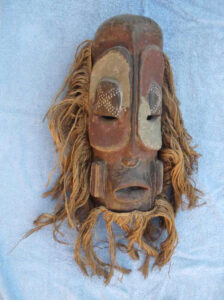 Frightening yet beautiful, this wooden and polychromed (painted with many colors) carved Bapende mask from Zaire belongs to a group collected by a world-famous celebrity. The current owner asked, “Where can I best sell these masks?” Indeed this collection is superb and varied.
Frightening yet beautiful, this wooden and polychromed (painted with many colors) carved Bapende mask from Zaire belongs to a group collected by a world-famous celebrity. The current owner asked, “Where can I best sell these masks?” Indeed this collection is superb and varied.
The late wife of a reader purchased the masks in the early 1980s in Nairobi, Kenya, from the collection of actor William Holden. Holden’s partner, Stefanie Powers, sold the masks to benefit The William Holden Wildlife Foundation, which she created after his death. The foundation still operates as an educational facility in Kenya. The Academy award-winning actor amassed a world class collection of masks, one of which ended up donated to the Palm Springs Art Museum in 1982.
Cultural Sensitivity of African Masks Collected During Colonial EraCapitalistic colonizers, French, English, and Belgian dealers acquired many in the 1920s. They realized the market potential of the taste for the exotic and the growing understanding of the abstract nature of modern art, conceptualized by artists such as Klee and Picasso.
The collection amassed by Holden (1918-1981) was known for its connoisseurship. He co-founded the Mount Kenya Safari Club (1959) and established a game ranch focused on wildlife preservation. As he grew older he became increasingly concerned with various animal species declining in population.
Another mask in the group is a Baule mask from the Ivory Coast. In the 1980s I served in the Peace Corps and took long weekends in the Ivory Coast. The Baule people inhabited the east side of the Ivory Coast, part of the Akan people of West Africa’s Ghana and the Ivory Coast, known for their gold talismans, brass castings, and wooden figural sculptures. Their masks are their foremost art form. I purchased mine in the mid 1980s and it hangs on a white wall in front of my desk.
During the last half of the 19th century to the first quarter of the 20th century, only an important individual from a powerful family owned such a Baule mask. When worn, the soul of the mask is transmuted through the “dancer’s” face. He, dancers were always male, transformed into the representation of the mask. He became a deity, an ancestor, or animal spirit. The mask allowed the spiritual world to interact with the physical world, facilitating communication between ancestors and heirs, humans and deities, humans and animals, low born villagers and high born, men and women, earth and sky.
Two Divine Beings at the Heart of Baile SpiritualityThese are the creator god Nyamien, and Asie, the God of the Earth, lord of humans and animals. The soul is immortal, and therefore beholden to its ancestors.
The mask pictured is a portrait mask and might depict a forebearer of the dancer. This mask shows the physical features of an honorable person: the slit-eyes represent modesty, the open mouth and folds, age, the hair and beard wisdom.
Let’s imagine this mask “danced” in a ceremony in the early 1900s. Before the ceremony this mask may have been kept “sleeping” in a personal shrine until its command performance in a “masquerade.” The masker or dancer wears a fiber costume, and danced to drums, to singing, and spoken words. The mask became the actor in a skit and the actor became the mask.
Here’s the cultural conundrum and why the sale of these masks is a delicate topic. Although this mask is a stunning three-dimensional work of art, the mask wasn’t intended as a wall-hanging. Why? The mask initiated movement. The mask holds the power to act, and to remain static on a wall belies its power. I’m to blame as well. My Baule mask is on my wall as I write this. I “see” form, color, texture, and abstraction of the human face. I KNOW I should feel, as did the Baule masker/dancer in 1900, its power of action and creation.
The static, formal properties of the mask “create” value for it in the European and US marketplace; the mask, if sold at auction, would realize over $2,000. I would suggest Skinner Bonhams auctions for the sale of such a mask.
The post How to Sell a Bapende Mask? appeared first on Elizabeth Appraisals.
August 17, 2025
Art Historian Brigette Ginter
Art Historian Brigette Ginter talks about art appraisal.
Watch Video

The post Art Historian Brigette Ginter appeared first on Elizabeth Appraisals.
August 12, 2025
Maxfield Parrish Prints a Great Addition to Any Wall
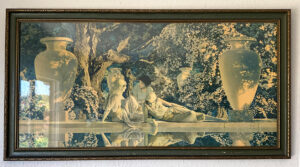 Maxfield Parrish (1870-1966), an American Quaker master of the fantastic, created a commercial style also recognized as fine art. Known as a book and magazine illustrator in great demand, an advertising man, the creator of a color called “Parrish Blue,” and one of the most popular artists of the 20th century. In 1936 Time magazine listed the three most popular artists, as far as fine art reproductions sales went, Cezanne, Van Gogh, and Parrish.
Maxfield Parrish (1870-1966), an American Quaker master of the fantastic, created a commercial style also recognized as fine art. Known as a book and magazine illustrator in great demand, an advertising man, the creator of a color called “Parrish Blue,” and one of the most popular artists of the 20th century. In 1936 Time magazine listed the three most popular artists, as far as fine art reproductions sales went, Cezanne, Van Gogh, and Parrish.
What does fantastic exotic art have to do with DC, who grew up in a Pedregosa Street 1900s home in Santa Barbara? In the early 1970s she and her brother became enchanted by The Lute Players (1924) and The Garden of Allah, prints by Maxfield Parrish. Let me explain the themes, and why in the 1970s DC fell love with works created in the first quarter of the 20th century.
Equally exotic Maxfield Parrish PrintsI’ll analyze a few of these that stem from a treasured myth:
Circe’s PalaceJason and the Talking OakAltas and The UniverseThe Landing of the Brazen Prince (Prince Agib)Queen Gulnave of the SeasThe Young King of the Black IslesLet’s take a few of these titles and see why the American public, like DC, became enchanted with Parrish. Illustrations. One reproducible work called Circe’s Palace pictures a beautiful seductress. The story, written in the early 19th century by Nathaniel Hawthorne retells the Greek myth of the witch Circe in Homer’s Odyssey. She beguilingly traps sailors on her island, feeds them a magic elixir, and turns them into other-than-humans. The story is filled with repressed desire, lust, loss of self, and exotic faraway places. Lots of blue sky and blue sea as well. Half naked beautiful nymphs and youths in shirtless togas too. Maybe not always togas; sometimes kilts, harem pants, loincloths, as Parrish set the scene for the imagination of the early 20th century.
American DreamsAmericans filled dreams with Persia dark eyed princes, Egyptian blazing bearded sorcerers, and handsome stoic Native American Braves.
In another famous Parrish illustration the gigantic Titan God Altas holds up the world among blue sky and high atmospheric clouds. Altas bears the weight of the world as a punishment for fighting the Olympians. Of course the handsome good shows off a beautiful strong man physique the envy of any young scrawny American farm boy.
The illustration that might have intrigued DC growing up in seaside Santa Barbara, Queen Gulnare of the Sea, shows a beautiful sea creature washed up on the shores of Persia discovered by the handsomest King Hamid. He falls in love with her even though she can’t speak. The image is filled with sorcery, enchantment, magical transformations, and more blue ocean and blue sky too.
Jason and the Talking Oak is modeled after Parrish’s own home in New Hampshire. The Oaks, in which a partially clad youth in 1910 takes advice on love from an ancient tree. This myth joins man and nature at a pivotal time in history before WWI.
The Landing of The Brazen Boatman tells a tale of a young Prince who loves and travels to her father’s palace on a raft. Escapism, sex, lust, and the color blue, the interests of a generation of Americans who never visited a museum.
A Great Addition to Any BookshelfNot only was Parrish a great addition to any wall, but he was also a great addition to any bookshelf. A talented illustrator, he published Arabian Knights: Their Best Known Tales in 1909. In 1910 Parrish published Nathanial Hawthorne’s A Wonder Book and Tanglewood Tales, The Golden Treasury of Songs and Lyrics, The Poems of Childhood. Magazines hired him, Colliers and Hearst’s, and Tire companies asked him to illustrate. When the ad trade began to fizzle, he signed deals for promotional ad calendars with General Electric and Edison Mazda Lamps. He painted themes of nude girls in landscape surroundings.
DC asked if the two prints were of any value. ONLY if those two were vibrant, uncirculated, undisplayed printer’s proofs. So many Parrish images were reproduced that unless you have a printer’s proof or—how unlikely—an original water color. The prints are worth about $200.
The post Maxfield Parrish Prints a Great Addition to Any Wall appeared first on Elizabeth Appraisals.
Elizabeth Stewart's Blog
- Elizabeth Stewart's profile
- 5 followers



